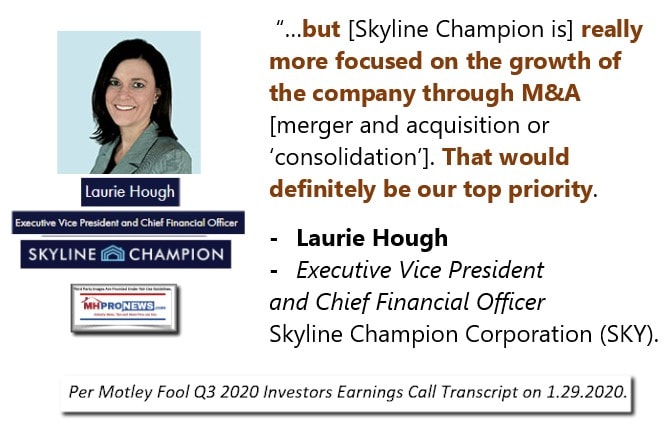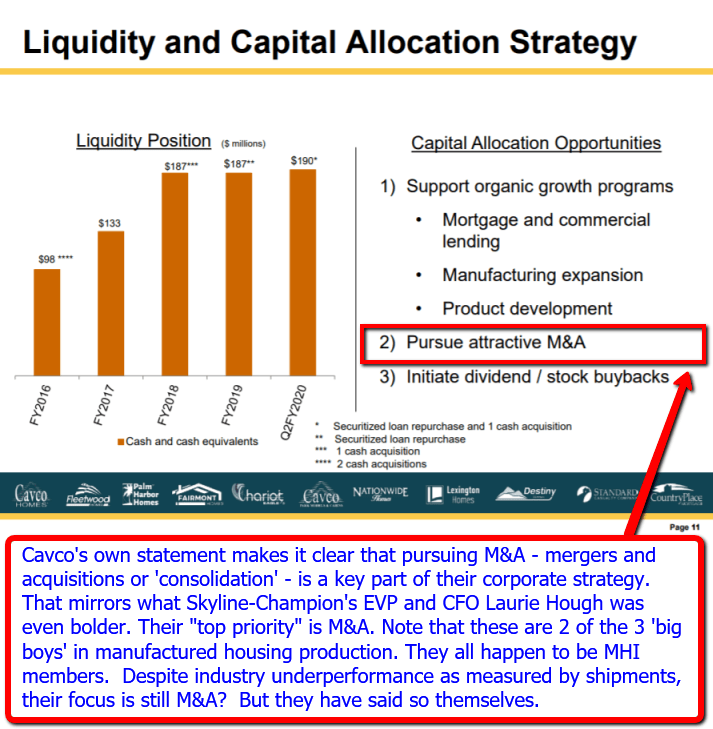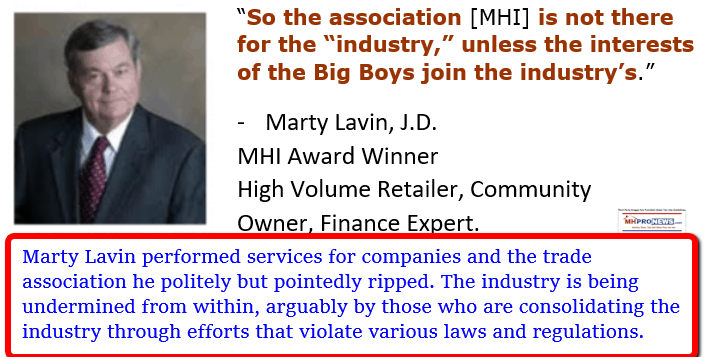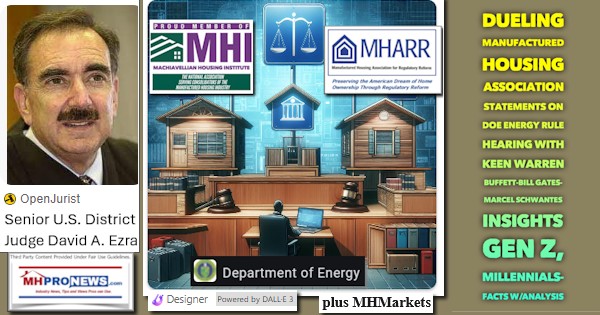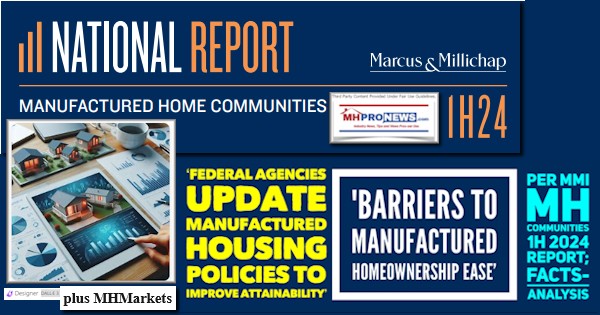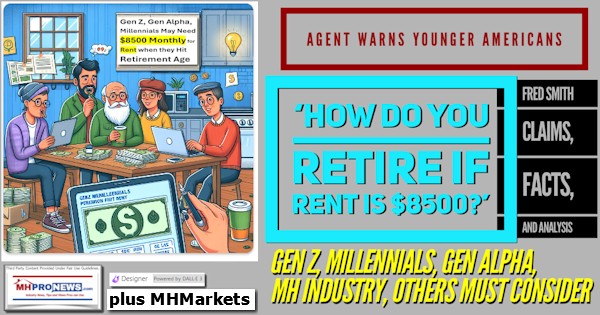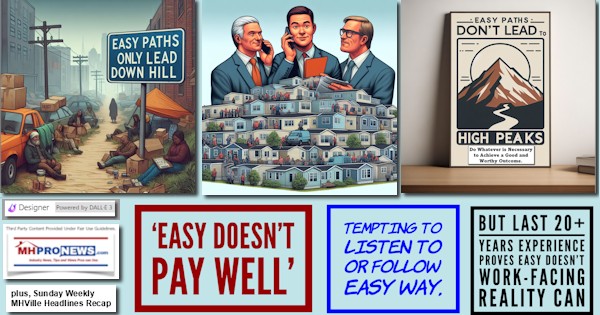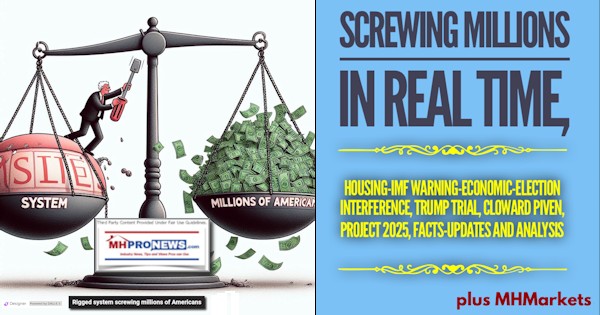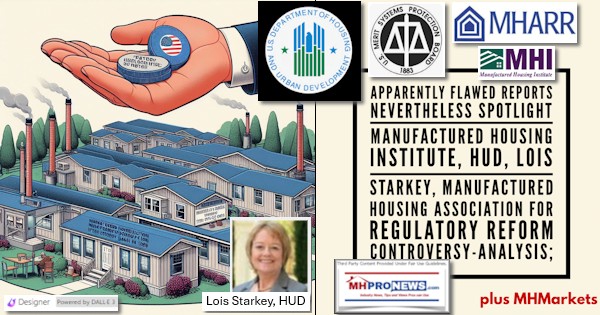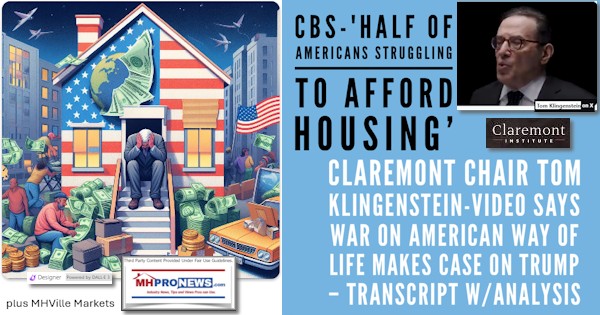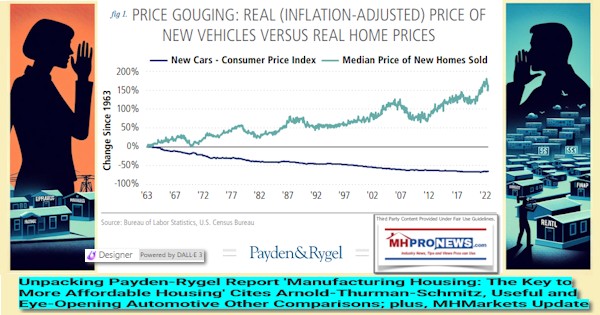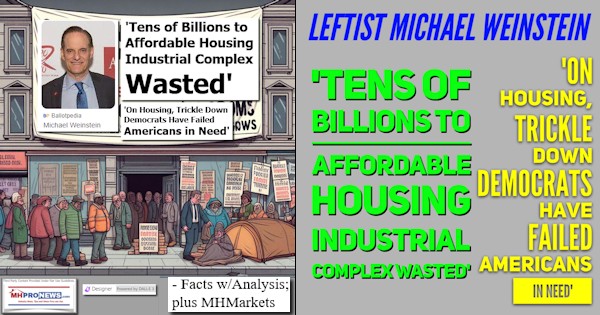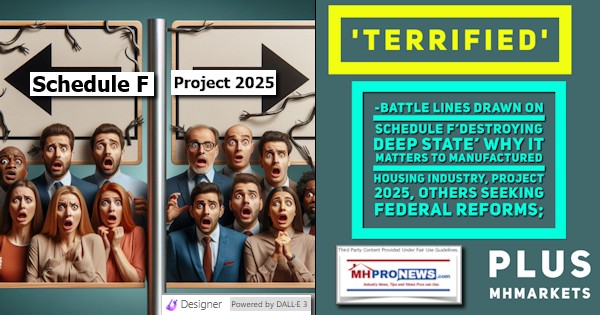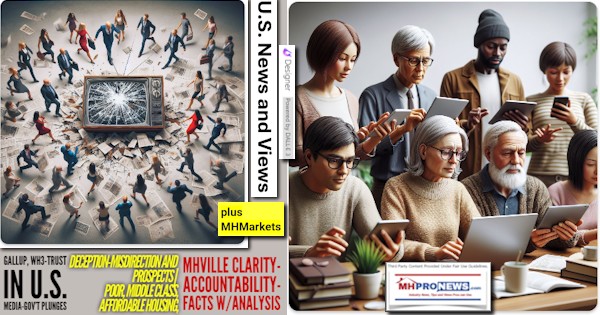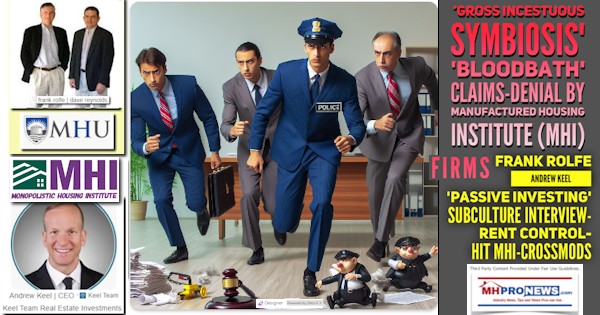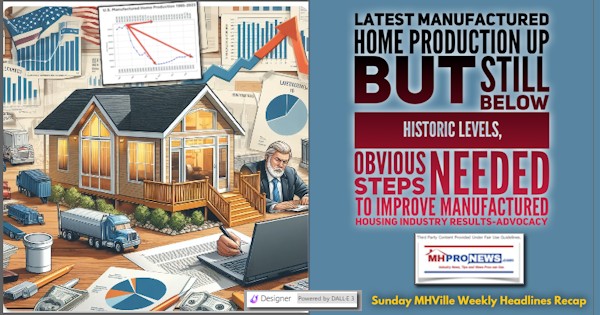Mark Yost, President and CEO of Skyline Champion (SKY) said on that “in the first 2 weeks of April, we [SKY] were running at 40% of last year’s levels. In the latter part of April, second half of April, we were at 60% of last year’s levels. And then most recently, in May, first 2 weeks of May, we’re running at 75% to 80% of last year’s levels. So it’s been increasing 20-ish percent per — every 2 weeks-ish through that time period. And I expect it to remain in that 75% to 80% through the remainder of the quarter, really driven on — sales is really not as much of the issue right now as production. So we’re ramping production back online to get our dealers product, and our dealers have — actually have seen very good demand. Many of the dealers are just now reopening. So as a result, they’re just able to take products. So it’s really a timing issue.”
That outline stated on 5.21.2020 might be a bright spot for those who fretted over the impact of the coronavirus pandemic on manufactured housing. This next pull quote from official SKY company statements below is even brighter.
“Despite the short-term headwinds, there are larger, longer-term potential tailwinds arising from COVID-19. We are seeing increased demand for people wanting to move from urban settings into rural environments, including the outskirts of the suburbs. This can be a very positive secular trend for us given the fact that manufactured housing has only 3% share in urban areas, but 15% of share in rural areas. In addition, the work-at-home movement will increase housing demand for homes that have larger square footage at an affordable price point and continued demand for alternative dwelling units as a place of sanctuary to use as your home office, workout facility, keep your parents safe or as an escape in your own backyard,” Yost said.
That’s a keen point made by Yost, as other media sources are reporting that in the wake of COVID19, interest in moving out of cities into more rural areas or smaller towns is growing. If that indeed becomes a trend, it could prove useful for manufactured housing industry professionals, investors and others involved in the HUD Code manufactured home industry.
However, that bright spot might be moderated by what Yost also said is a tightening of some credit standards in the wake of the wave of unemployment from the Wuhan Virus outbreak. There are more insights on wholesale and retail credit or other data claims in the more detail statements that follows.
Among them?
On May 21, 2020 Yost also said: “Now today, about 90% of the retailers, I would estimate, are active and open. They maybe only have 1 person in the office, social distancing or doing more online. But I would say the actual traffic and closing ratio — while traffic is down, the closing ratio is so high that I would say several retailers are experiencing all-time record volumes in certain parts of the country.”
Those are more than enough teasers to encourage diving into the numerous insider insights from Skyline Champion’s recent fourth quarter and fiscal 2020 results.
To set the context for their 5.21.2020 Quarter 4 2020 Skyline Champion Corp Earnings Call, their media release through Berkshire Hathaway owned Business Wire on the prior day is useful and relevant.

May 20, 2020
TROY, Mich.–(BUSINESS WIRE)– Skyline Champion Corporation (NYSE:SKY) (“Skyline Champion”), today announced financial results for its fourth quarter and full year ended March 28, 2020 (“fiscal 2020”) and provided an update on business conditions as it responds to the impact of COVID-19.
“Our people and our partners have proven their agility and resiliency as they embraced unique and difficult challenges over the last two months,” said Mark Yost, Skyline Champion’s President and Chief Executive Officer. “I am very pleased with how we have navigated and performed through this period of near-term uncertainty. Importantly, our people have operated effectively and safely.”
“We entered the pandemic from a position of strength as we grew fourth quarter sales orders by 14% through the first eleven weeks of the quarter, even as the geographies we serve were softer. In response to COVID-19, we have been carefully managing our expenses by reducing non-essential spending, and furloughing certain employees, with many now taking advantage of benefits provided by the CARES Act. We previously announced temporary facility closures and have seen a decline in demand as a result of stay-at-home restrictions and the temporary closure of a myriad of our independent retailers. We are encouraged that we were able to reopen many of those closed locations in late April, at reduced production levels due to social distancing protocols and decreased demand. We will continue to manage our footprint and be prepared to reopen additional facilities as restrictions are eased and when demand warrants.”
“While the economic impact of COVID-19 on Skyline Champion’s fiscal 2021 results is uncertain at this time, we are confident about the long-term demand for attainable and sustainable housing. During this period, we are continuing to invest in strategic initiatives such as simplifying and digitizing our product offerings that we believe will add value to our customers and further enhance our performance. With our solid liquidity position and decisive actions taken across the organization, we believe we are well positioned to manage through the current environment and prepared to grow when conditions improve.”
Fourth Quarter Fiscal 2020 Highlights (compared to Fourth Quarter Fiscal 2019)
- Net sales decreased 8.1% to $301.1 million
- S. factory-built homes sold decreased 4.8% to 4,603
- Gross profit as a percent of sales declined by 40 basis points to 19.9%
- Net income decreased by 34.5% to $6.0 million
- Earnings per share (“EPS”) decreased to $0.11 from $0.16
- Excluding non-recurring expenses, Adjusted EPS decreased to $0.14 from $0.26
- Adjusted EBITDA decreased 17.0% to $20.1 million
- Adjusted EBITDA margin decreased by 70 basis points to 6.7%
- Borrowed $38.0 million on revolving credit facility to maximize financial flexibility
- Full Year Fiscal 2020 Highlights (compared to Full Year Fiscal 2019)
- Net sales increased 0.7% to $1,369.7 million
- S. factory-built homes sold increased 3.4% to 20,110
- Gross profit as a percent of sales expanded by 240 basis points to 20.4%
- Net income was $58.2 million, compared to net loss of $58.2 million (fiscal 2019 includes $101.0 million in non-cash, equity-based compensation expense)
- EPS was $1.02 compared to net loss per share of $1.09
- Excluding non-recurring expenses, Adjusted EPS increased to $1.15 from $1.04
- Adjusted EBITDA increased 17.8% to $114.4 million
- Adjusted EBITDA margin expanded by 120 basis points to 8.3%
- Net operating cash flows increased to $76.7 million from $65.2 million
“Skyline Champion delivered solid results for Fiscal 2020, achieving double digit growth in Adjusted EBITDA and cash from operations. Our profitability initiatives gained traction, driving margin expansion for both gross profit and Adjusted EBITDA. We achieved these results despite modest growth in net sales for the full year and some softening during the fourth quarter,” Yost concluded.
Fourth Quarter Fiscal 2020 Results
Net sales for the fourth quarter fiscal 2020 decreased 8.1% to $301.1 million compared to the prior-year period. The number of U.S. factory-built homes sold by Skyline Champion in the fourth quarter fiscal 2020 decreased 4.8% to 4,603 compared to the prior year fourth quarter primarily due to the temporary idling of up to 20 U.S. production facilities in the last weeks of March. The average selling price (“ASP”) per U.S. home sold decreased 1.4% to $60,200. ASP decreased primarily due to a shift in product mix to more single section home sales. The number of Canadian factory-built homes sold in the quarter declined to 130 homes compared to 229 homes in the prior-year period primarily from a reduction in oil-related demand drivers. Total backlog for Skyline Champion was $127.5 million as of March 28, 2020 compared to $142.7 million as of March 30, 2019. Backlogs decreased $5.6 million during the quarter compared to $38.6 million in the fiscal fourth quarter of 2019 driven by the improvement in sales orders in the fourth quarter of fiscal 2020.
Gross profit decreased by 9.7% to $60.0 million in the fourth quarter fiscal 2020 compared to the prior-year period. Gross profit was 19.9% of net sales, a 40-basis point reduction compared to 20.3% in the fourth quarter fiscal 2019. Gross profit compression was primarily due to the reduction in net sales and increase in labor inflation partially offset by material pricing.
Selling, general and administrative expenses (“SG&A”) in the fourth quarter fiscal 2020 decreased to $47.2 million from $53.1 million in the same period last year due to a reduction in equity-based compensation, variable incentive compensation, and acquisition integration costs.
Net income for the fourth quarter fiscal 2020 was $6.0 million, compared to net income of $9.2 million during the same period from the prior year. The decrease in net income was mainly driven by the decline in gross profit and increased income tax expense, and was partially offset by reductions in SG&A. EPS decreased to $0.11 for the fourth quarter fiscal 2020 compared to $0.16 in the same period of the prior year. Excluding non-recurring expenses, Adjusted EPS decreased to $0.14 for the fourth quarter of fiscal 2020 compared to $0.26 during the same period of the prior year.
Adjusted EBITDA for the fourth quarter fiscal 2020 decreased by 17.0% to $20.1 million compared to the fourth quarter fiscal 2019. The decrease was primarily driven by lower sales volumes and reduced gross profit. Adjusted EBITDA margin declined by 70 basis points to 6.7%.
As of March 28, 2020, Skyline Champion had $209.5 million of cash and cash equivalents.
Full Year Fiscal 2020 Financial Highlights
For fiscal 2020, net sales were $1,369.7 million which represents an increase of 0.7%, or $9.7 million, compared to fiscal 2019.
Gross profit increased $33.6 million or 13.7% to $279.0 million for fiscal 2020, compared to $245.4 million for the prior year period. Gross profit increased 240 basis points to 20.4% of net sales for fiscal 2020, compared to fiscal 2019.
SG&A decreased to $192.5 million for fiscal 2020, compared to $275.1 million in the prior year period, mostly driven by a decrease in equity-based compensation expense, as well as reduced transaction and integration related expenses resulting from the Skyline acquisition that were incurred in the prior year.
Net income for fiscal 2020 was $58.2 million, compared to net loss of $58.2 million for fiscal 2019.
Adjusted EBITDA for fiscal 2020 increased by 17.8% to $114.4 million, compared to $97.1 million for fiscal 2019.
…
About Skyline Champion Corporation:
Skyline Champion Corporation (NYSE: SKY) was formed on June 1, 2018 as the result of the combination of Skyline Corporation (“Skyline”) and the operating assets of Champion Enterprises Holdings, LLC (“Champion”). The combined company employs approximately 6,600 people and is the largest independent, publicly traded, factory-built housing company in North America. With more than 65 years of homebuilding experience and 38 manufacturing facilities throughout the United States and western Canada, Skyline Champion is well positioned with a leading portfolio of manufactured and modular homes, ADUs, park-models and modular buildings for the multi-family, hospitality, senior and workforce housing sectors.
In addition to its core home building business, Skyline Champion operates a factory-direct retail business, Titan Factory Direct, with 21 retail locations spanning the southern United States, and Star Fleet Trucking, providing transportation services to the manufactured housing and other industries from several dispatch locations across the United States.
Skyline Champion builds homes under some of the most well known brand names in the factory-built housing industry including Skyline Homes, Champion Home Builders, Genesis Homes, Athens Park Models, Dutch Housing, Excel Homes, Homes of Merit, New Era, Redman Homes, Shore Park, Silvercrest, Titan Homes in the U.S., and Moduline and SRI Homes in western Canada.
Presentation of Non-GAAP Financial Measures
In addition to the results provided in accordance with U.S. generally accepted accounting principles (“U.S. GAAP”) throughout this press release, Skyline Champion has provided non-GAAP financial measures—Adjusted EBITDA, Adjusted EBITDA Margin, and Adjusted Earnings Per Share (including dilutive securities, if any)—which present operating results on a basis adjusted for certain items. Skyline Champion uses these non-GAAP financial measures for business planning purposes and in measuring its performance relative to that of its competitors. Skyline Champion believes that these non-GAAP financial measures are useful financial metrics to assess its operating performance from period-to-period by excluding certain items that Skyline Champion believes are not representative of its core business. These non-GAAP financial measures are not intended to replace, and should not be considered superior to, the presentation of Skyline Champion’s financial results in accordance with U.S. GAAP.
Skyline Champion defines Adjusted EBITDA as net income or loss plus (a) the provision for income taxes, (b) interest expense, net, (c) depreciation and amortization, (d) gain or loss from discontinued operations, (e) foreign currency gains and losses, (f) equity-based compensation awards granted before December 31, 2018, (g) restructuring charges, (h) impairment of assets, and (i) other non-operating costs including those for the acquisition and integration of businesses. Adjusted EBITDA is not a measure of earnings calculated in accordance with U.S. GAAP, and should not be considered an alternative to, or more meaningful than, net income or loss, net sales, operating income or earnings per share prepared on a U.S. GAAP basis. Skyline Champion believes that Adjusted EBITDA is commonly used by investors to evaluate its performance and that of its competitors. However, Skyline Champion’s use of Adjusted EBITDA may vary from that of others in our industry. Adjusted EBITDA is reconciled from the respective measure under U.S. GAAP in the tables below. Adjusted EBITDA Margin is calculated as Adjusted EBITDA divided by net sales reported in the statement of operations. Adjusted EPS is calculated as net income or loss plus (a) equity-based compensation awards granted before December 31, 2018, (b) restructuring charges, (c) impairment of assets, and (d) other non-operating costs including those for the acquisition and integration of businesses, including the related tax effect, if any, on these items.
Forward-Looking Statements
Statements in this press release, including certain statements regarding Skyline Champion’s strategic initiatives, and future market demand are intended to be covered by the safe harbor for “forward-looking statements” provided by the Private Securities Litigation Reform Act of 1995. These forward-looking statements generally can be identified by use of words such as “believe,” “expect,” “future,” “anticipate,” “intend,” “plan,” “foresee,” “may,” “could,” “should,” “will,” “potential,” “continue,” or other similar words or phrases. Similarly, statements that describe objectives, plans, or goals also are forward-looking statements. Such forward-looking statements involve inherent risks and uncertainties, many of which are difficult to predict and are generally beyond the control of Skyline Champion. Skyline Champion cautions readers that a number of important factors could cause actual results to differ materially from those expressed in, implied, or projected by such forward-looking statements. Risks and uncertainties include regional, national and international economic, financial, public health and labor conditions, and the following: the COVID-19 pandemic, which has had, and could continue to have, significant adverse effects on us; the cyclicality and seasonality of the housing industry and its sensitivity to changes in general economic or other business conditions; demand fluctuations in the housing industry; supply-related issues; labor-related issues; the possible unavailability of additional capital when needed; competition and competitive pressures; changes in consumer preferences for our products or our failure to gauge those preferences; quality problems, including the quality of parts sourced from suppliers and related liability and reputational issues; data security breaches, cybersecurity attacks, and other information technology disruptions, exacerbated by the COVID-19 pandemic; the extensive regulation affecting the production and sale of factory-built housing and the effects of possible changes in laws with which we must comply; the potential impact of natural disasters on sales and raw material costs; the risks associated with possible mergers and acquisitions; the prices and availability of materials; periodic inventory adjustments by, and changes to relationships with, independent retailers; changes in interest and foreign exchange rates; insurance coverage and cost issues; the possibility that all or part of our goodwill might become impaired; the possibility that our risk management practices may leave us exposed to unidentified or unanticipated risks; and other risks set forth in the “Risk Factors” section, the “Legal Proceedings” section, the “Management’s Discussion and Analysis of Financial Condition and Results of Operations” section, and other sections, as applicable, in our Annual Reports on Form 10-K, including our Annual Report on Form 10-K for the fiscal year ended March 30, 2019 previously filed with the Securities and Exchange Commission (“SEC”), as well as in our Quarterly Reports on Form 10-Q, and Current Reports on Form 8-K, filed with or furnished to the SEC.
If any of these risks or uncertainties materializes or if any of the assumptions underlying such forward-looking statements proves to be incorrect, then the developments and future events concerning Skyline Champion set forth in this press release may differ materially from those expressed or implied by these forward-looking statements. You are cautioned not to place undue reliance on these statements, which speak only as of the date of this release. We anticipate that subsequent events and developments will cause our expectations and beliefs to change. Skyline Champion assumes no obligation to update such forward-looking statements to reflect events or circumstances after the date of this document or to reflect the occurrence of unanticipated events, unless obligated to do so under the federal securities laws.
##
Much of the early part of the earnings conference call on May 21, 2020 repeats information from the above. That said, the Q&A that follows the opening comments reveals some additional insights.
The SKY earnings presentation and Q&A will be followed by a brief MHProNews analysis and commentary.
Edited Transcript of SKY earnings conference call or presentation
21-May-20 12:00pm GMT
Q4 2020 Skyline Champion Corp Earnings Call
ELKHART May 21, 2020 (Thomson StreetEvents) — Edited Transcript of Skyline Champion Corp earnings conference call or presentation Thursday, May 21, 2020 at 12:00:00pm GMT
TEXT version of Transcript
================================================================
Corporate Participants
================================================================
* Laurie M. Hough
Skyline Champion Corporation – Executive VP, CFO & Treasurer
* Mark J. Yost
Skyline Champion Corporation – President, CEO & Director
* Sarah Janowicz
================================================================
Conference Call Participants
================================================================
* Collin Andrew Verron
Jefferies LLC, Research Division – Equity Associate
* Daniel Joseph Moore
CJS Securities, Inc. – MD of Research
* Gregory William Palm
Craig-Hallum Capital Group LLC, Research Division – Senior Research Analyst
* Matthew Adrien Bouley
Barclays Bank PLC, Research Division – VP
* Michael Glaser Dahl
RBC Capital Markets, Research Division – MD of U.S. Homebuilders & Building Products
* Rohit Seth
SunTrust Robinson Humphrey, Inc., Research Division – Associate
================================================================
Presentation
——————————————————————————–
Operator [1]
——————————————————————————–
Good morning, and welcome to Skyline Champion Corporation’s Fourth Quarter Fiscal Year 2020 Earnings Call. The company issued an earnings press release yesterday after the close. I would now like to introduce your host for today’s call, Sarah Janowicz, the company’s Director of Investor Relations and External Reporting. Sarah, please go ahead.
——————————————————————————–
Sarah Janowicz, [2]
——————————————————————————–
Good morning, and thank you for participating in our earnings call to discuss our fourth quarter and full year results. We will also provide an update on current business conditions and how the company is navigating the COVID-19 pandemic. Joining me on today’s call is Mark Yost, President and CEO; and Laurie Hough, EVP and CFO. I would like to remind everyone that yesterday’s press release and statements made during this call include forward-looking statements within the meaning of the Private Securities Litigation Reform Act of 1995. These statements are subject to risks and uncertainties that could cause actual results to differ materially from our expectations and projections. Such risks and uncertainties include the factors set forth in the earnings release and in our filings with the Securities and Exchange Commission.
Additionally, during today’s call, we will discuss non-GAAP measures, which we believe can be useful in evaluating our performance. A reconciliation of these measures can be found in the earnings release.
I would now like to turn the call over to Mark.
——————————————————————————–
Mark J. Yost, Skyline Champion Corporation – President, CEO & Director [3]
——————————————————————————–
Thank you, Sarah, and good morning, everyone. To begin, I hope everyone on this call and their families are well as we navigate the COVID-19 pandemic. I am proud of the resiliency of our team during this challenging time. The health and safety of our employees and our customers remain our highest priority. Today, I will briefly talk about our full year and fourth quarter results, then provide you an update on the activity so far in our first fiscal quarter and thoughts about the balance of the year.
I am pleased with the results Skyline Champion delivered in fiscal 2020. We grew adjusted EBITDA by 18% to $114 million for the year. We improved safety and turnover, increased margins, realized our run rate synergies from last year’s merger, finished the integration of the company’s IT systems, completed the implementation of Sarbanes-Oxley, invested in our people, automation and digital go-to-market platforms as well as launched our Genesis brand of products. I am proud and appreciative of our team for their accomplishments this year.
Turning to the fourth quarter. Revenue was down 8%, primarily due to the temporary idling of 24 factories in the final weeks of March and outsized industry growth in regions where we do not currently have a significant presence.
With the COVID-19-related government restrictions and stay-at-home orders in the U.S., our customers canceled approximately 150 units and placed on hold an additional 250 units in addition to the impact of the temporary idling of plants, which reduced production by between 200 and 250 units in U.S. The U.S. HUD market rebounded during the quarter, growing 13%, with strong growth in the mid southern markets.
Even as the industry experienced strong growth rates, the major markets we serve today, including California, Michigan and Florida, saw quarter-over-quarter declines, resulting in industry growth in our markets in the flat-to-low single-digit range, primarily due to the timing of orders from the community channel. I was impressed with the U.S. team’s ability to grow sales orders by 11% year-over-year during the quarter in lower growth regions given the impact of COVID-19 and without the benefit of outsized backlogs last year.
Our Canadian operations were impacted by oil-related impacts during the quarter and saw volume declines of 43%.
Turning to more recent events. I would like to commend our team for their swift execution of plans and protocols in response to the unprecedented challenges brought on by COVID-19 pandemic.
Skyline Champion has prioritized the safety and well-being of our employees, customers and communities in which we operate. Employees have been encouraged to work from home where possible. In our operating facilities, we’ve implemented social distance guidelines and have increased safety and sanitation standards.
In response to rapidly announced stay-at-home orders late in March, we temporarily idled 20 of our 33 U.S. facilities during the last weeks of March. From that time, we’ve worked closely with all of our stakeholders to thoroughly manage the changes to our supply base, our employees’ well-being and our customer needs.
In the first 7 weeks of our fiscal 2021, we have seen large geographic differences related to demand. Within the U.S., like many housing companies, we continue to see stronger demand in the Southwest, while short-term demand in the Midwest and Northeast have been hit the hardest as they suffered from the largest virus outbreaks and restrictive shutdown measures. Consistent with this trend, we have been more severely impacted in states like Pennsylvania and New York, where we operate 7 of our production lines.
Since late March, we reduced production levels within our plants to accommodate social distancing guidelines, in addition to running partial work weeks at some facilities due to decreased demand. Importantly, we have reopened 18 of our 20 idled U.S. plants over the first 7 weeks of our fiscal 2021, and we’ll open another plant next week.
As we look at production trends in U.S. so far this quarter, in early April, we operated at about 40% of last year’s production volumes, moving up to 60% of last year’s levels in mid- to late April, and more recently in May, improving to 75% to 80% of last year’s levels. We anticipate production remaining in this range for the remainder of the quarter and expect overall industry growth for the year to be in line with overall site-built estimates.
Before the implementation of the CARES Act, we acted quickly to roll out a safety net, temporary emergency sick pay policy, which allowed for limited pay for our employees impacted by COVID-19. With the CARES Act, we furloughed most employees at the temporary idled facilities, with those furloughed employees maintaining health care benefits and job status. Our employees have responded and our attendance is better than it has historically been at several plants.
In addition to the 20 U.S. factories, we also announced the temporary idling of our 5 Western Canadian plants due to the decline caused by lower oil prices. Our Canadian facilities have been running at lower sales volumes than last year throughout fiscal 2020. The plants were reopened at reduced production levels intermittently throughout April. Demand in Western Canada is expected to remain low for the remainder of the first quarter and possibly the rest of fiscal 2021. We will continue to adjust production levels and operations as demand warrants.
During the 7 weeks since our year ended, production at our Canadian factories is at 65% of the level seen in the same period of the prior year. We are staying in close contact with our customers who have also been impacted by the virus and related stay-at-home orders. In some states and provinces, retailers have been required to temporarily close, while others have moved to more online selling. Although it varies by state, in talking to our U.S. retailers, they have seen a 40% to 60% reduction in walk-in traffic, but the closing ratio was higher. So they’ve seen better conversion into sales compared to typical levels.
Our company-owned retail centers have also experienced reduced traffic, but have increased appointments for virtual home tours and have enhanced the use of digital selling tools. To help our dealers through this time, we have partnered with some of the industry floor plan lenders to defer curtailment payments for up to 120 days, which will help our independent retail base better manage their liquidity.
Similar to the homebuilding industry, we are seeing lenders tighten credit and verifying employment status in advance of loan closings.
Despite the short-term headwinds, there are larger, longer-term potential tailwinds arising from COVID-19. We are seeing increased demand for people wanting to move from urban settings into rural environments, including the outskirts of the suburbs. This can be a very positive secular trend for us given the fact that manufactured housing has only 3% share in urban areas, but 15% of share in rural areas. In addition, the work-at-home movement will increase housing demand for homes that have larger square footage at an affordable price point and continued demand for alternative dwelling units as a place of sanctuary to use as your home office, workout facility, keep your parents safe or as an escape in your own backyard.
I will now turn the call over to Laurie to discuss the quarterly financials in more detail as well as actions we’ve taken to preserve our solid liquidity position.
——————————————————————————–
Laurie M. Hough, Skyline Champion Corporation – Executive VP, CFO & Treasurer [4]
——————————————————————————–
Thanks, Mark, and good morning, everyone. I will begin by reviewing our financial results, followed by a discussion of our balance sheet as well as financial actions we have taken in response to the COVID-19 pandemic.
Net sales decreased by 8% to $301 million in the fourth quarter. We saw revenue declines of $18.3 million in the U.S. factory-built housing segment as well as declines in our Canadian factory-built housing segment of $7.4 million. The decline in U.S. factory-built revenue was primarily driven by a reduction of approximately 234 homes sold to 4,603 homes compared to the same quarter last year.
A 1% decline in the average selling price per U.S. homes sold to $60,200 also contributed to the decrease in revenue. The decline in the average selling price was due to a shift in product mix as we sold a larger percentage of single-section homes this quarter versus the same quarter last year.
Canadian revenue decreased 40% to $11 million, driven by a 43% decline in the number of homes sold in the quarter. Average home selling prices increased by 6% to $86,800. Our Canadian business was impacted by the continued reduction in oil prices in Western Canada. Consolidated gross profit decreased to $60 million, down almost 10% versus the prior year quarter. Our U.S. Housing segment gross margins were 20% of segment net sales, down 60 basis points from the fourth quarter last year. Gross margins were impacted by reduced sales volumes, labor inflation as well as temporary plant closures due to COVID-19 shutdown orders.
SG&A in the fourth quarter decreased to $47 million versus $53 million in the same quarter last year. The decrease was primarily due to a reduction in noncash equity-based compensation expense, variable incentive compensation and integration costs.
Net income for the fourth quarter was $6 million or $0.11 per share compared to net income of $9.2 million or earnings of $0.16 per share during the same period in the prior year, driven by a combination of lower gross profit and higher income tax expense, which were partially offset by reductions in SG&A.
On an adjusted basis, we generated $0.14 of net income per diluted share compared to $0.26 in the year-ago quarter. The company’s effective tax rate for the 3 months ended March 28, 2020, was 51.8% versus an effective tax rate of 25.9% for fiscal 2019’s fourth quarter. The change in the effective rate was primarily due to increases in deferred tax asset valuation allowances, partially offset by the recognition of certain tax credits and a reduction of tax reserves. Adjusted EBITDA for the quarter was $20.1 million, a decrease of 17% over the same period a year ago. The adjusted EBITDA margin compressed by 70 basis points to 6.7%, largely due to lower production volumes.
At the end of March 2020, our consolidated backlog was $127 million compared to backlog last March of $143 million as we started fiscal 2020 fourth quarter with $48 million less of backlog, which was partially offset by improved sales orders. Current U.S. backlogs are up slightly since quarter end and are averaging 6 weeks of production in mid-May, but at lower production volumes due to social distancing protocols and reduced workweek schedules, which we expect to negatively impact first quarter margins.
As of mid-May, Canadian backlogs are down 35% from this time last year. We will continue to modify production schedules in order to manage the short-term challenges associated with the COVID-19 virus.
As of March 28, 2020, we had $209 million of cash and cash equivalents. During the quarter, in order to maximize financial flexibility, we borrowed an additional $38 million on our revolving credit facility. The incremental borrowings will be used to offset temporary working capital impacts of production shutdowns and to preserve financial flexibility to continue to invest in strategic priorities as current conditions allow. We ended the year with $77 million of long-term debt outstanding with no material debt maturities until June 2023.
I’ll now discuss the COVID-related financial actions we’ve taken. We moved swiftly to increase our cash position and liquidity, while reducing or deferring controllable expenses in order to minimize cash spend. We’ve reduced nonessential capital expenditures, but are continuing to invest in strategic initiatives related to automation and digital go-to-market platforms in order to lower our costs and bring benefits to our customers.
Additionally, we implemented compensation savings by closely monitoring overtime and through furloughing and layoffs of employees. We will continue to monitor SG&A costs and adjust as necessary while balancing our ability to return to normal operating levels as quickly as possible when demand dictates.
Given the limited visibility on the trajectory of the virus and pass to a more normal operating environment, we are withdrawing our previous view of reaching 10% EBITDA margins in the next 18 months. We have taken many actions that will enable us to continue to support the company and all its stakeholders should the impact of COVID-19 persist well into fiscal 2021. We are confident that we have the financial strength and flexibility to continue to offer quality built affordable housing to our customers in these unprecedented times and allow us to be well prepared when conditions improve.
I’ll now turn the call back to Mark for some closing remarks.
——————————————————————————–
Mark J. Yost, Skyline Champion Corporation – President, CEO & Director [5]
——————————————————————————–
Thanks, Laurie. We are pleased with the incremental improvements we achieved in fiscal 2020, as we progressed along our path to reaching our medium- and long-term goals. As we manage through the day-to-day challenges brought on by the pandemic, we are continuing to focus and invest in our strategic initiatives of streamlining our products, digital offerings to our customers and adding more value and sustainability through turnkey services and the elimination of waste. We anticipate that these actions will provide benefits, both in the near-term and in the years to come.
As we look forward, we expect housing demand to benefit from tailwinds that will generate new opportunities for our business. Through this, Skyline Champion will continue to provide high-quality sustainable, affordable housing solutions for our customers and their families. Our ultimate goal is to make dream home attainable for everyone. We will continue to demonstrate resilience through these unprecedented times and will be here to support the need for housing as the economy recovers.
And with that, operator, you may now open the lines for Q&A.
================================================================================
Questions and Answers
——————————————————————————–
Operator [1]
——————————————————————————–
(Operator Instructions) Our first question today is coming from Mike Dahl from RBC Capital Markets.
——————————————————————————–
Michael Glaser Dahl, RBC Capital Markets, Research Division – MD of U.S. Homebuilders & Building Products [2]
——————————————————————————–
Hope you guys and your teams are — and families are all well.
——————————————————————————–
Mark J. Yost, Skyline Champion Corporation – President, CEO & Director [3]
——————————————————————————–
Thanks, Mike.
——————————————————————————–
Michael Glaser Dahl, RBC Capital Markets, Research Division – MD of U.S. Homebuilders & Building Products [4]
——————————————————————————–
Mark, I wanted to revisit a couple of comments you made around production levels and just to make sure we understood them correctly, and I may have missed a part of it, but you were talking about kind of production rates as a percentage of last year as we moved through April and May. Can you just give us — can you repeat those or give us a sense of just quarter-to-date what your shipment volumes are down in both the U.S. and Canada?
——————————————————————————–
Mark J. Yost, Skyline Champion Corporation – President, CEO & Director [5]
——————————————————————————–
Yes. So Mike, in the first 2 weeks of April, we were running at 40% of last year’s levels. In the latter part of April, second half of April, we were at 60% of last year’s levels. And then most recently, in May, first 2 weeks of May, we’re running at 75% to 80% of last year’s levels. So it’s been increasing 20-ish percent per — every 2 weeks-ish through that time period. And I expect it to remain in that 75% to 80% through the remainder of the quarter, really driven on — sales is really not as much of the issue right now as production. So we’re ramping production back online to get our dealers product, and our dealers have — actually have seen very good demand. Many of the dealers are just now reopening. So as a result, they’re just able to take products. So it’s really a timing issue.
——————————————————————————–
Michael Glaser Dahl, RBC Capital Markets, Research Division – MD of U.S. Homebuilders & Building Products [6]
——————————————————————————–
Got it. Okay. So if I look at your expectation, then it would come out to be roughly down 30% to 35% in the U.S. if I think about those run rates for the full quarter?
——————————————————————————–
Mark J. Yost, Skyline Champion Corporation – President, CEO & Director [7]
——————————————————————————–
Yes. I’d have to do the weighted average, Mike. But yes, in essence, that sounds mathematically in the ballpark. Yes. And then as far as — I think you also asked on Canada. In Canada, thus far, for the first 7 weeks of the quarter, we’re running at 65% of prior year levels in our Canadian operation.
——————————————————————————–
Michael Glaser Dahl, RBC Capital Markets, Research Division – MD of U.S. Homebuilders & Building Products [8]
——————————————————————————–
Okay. All right. Then my second question is a follow-up. And I think it’s along the same lines, you made a comment that you’d expect industry shipments about flat with — or consistent with site-build estimates are — there’s some pretty varied range right now. So 2-part question. One would be, when you’d say in line with those, what are you using as kind of a consensus for site-built numbers? And then the second part is, bigger picture, I think a lot of us are on board with the idea that there’s some real tailwinds to manufactured housing growth over the coming years, but from a near-term standpoint, you do have a customer base that’s particularly economically sensitive. You have some potential disruption in the financing improvement thematic. You’ve got developers that may put things on hold. So I guess I’m — what I’d like to know is, given those factors, why do you — why is that your expectation that manufactured housing can kind of hold its share in the near term?
——————————————————————————–
Mark J. Yost, Skyline Champion Corporation – President, CEO & Director [9]
——————————————————————————–
I think — so first off, I’m probably in the 15% to 20% range in terms of the full year kind of number. I think right now, the CARES Act is acting as a — instead of kind of unemployment insurance, it’s acting more as a stimulus package to certain wage-level demographics in the country. So I think we’re getting a short-term bump, and we’re seeing that. I’m concerned what happens after July, depending on what happens, obviously, in the government’s actions that they take. But overall, I think there’s a tremendous movement. Our retailers are telling us that their business activity level on a whole, and it’s very sporadic, obviously, is exceptionally strong. We’ve seen 2 or 3 weeks ago, about 60% of the retail base in the country, roughly, was idled or maybe shut down because of stay-at-home orders or other such items. Now today, about 90% of the retailers, I would estimate, are active and open. They maybe only have 1 person in the office, social distancing or doing more online. But I would say the actual traffic and closing ratio — while traffic is down, the closing ratio is so high that I would say several retailers are experiencing all-time record volumes in certain parts of the country.
So it is sporadic, but I think there’s a demand for housing that’s pent up. And I think we’re seeing that type of traffic pattern at many of our retail base. I think it’s going to be the community channel that is going to watch rents and payments come in over the next few months before they start to really return back to the market. They have started to return, but I think it’s going to be more of a slow drip over the next few months until they have some assurances that maybe they can have a payment stream coming into them before they start placing orders for new homes.
So I think, on whole, I’m very bullish because we are seeing more activity in rural areas of people interested in acquiring on homes, and we’re also seeing tremendous number of companies who are moving to the work-from-home-type policies. That’s not hit just yet. But with those 2 trends, and given our — the predominant amount of sales that we have going into rural areas, that’s a huge long-term positive for us. So it just depends on how fast that shift happens, and I’m anticipating that will start to happen more towards the fall of this year.
——————————————————————————–
Operator [10]
——————————————————————————–
Our next question today is coming from Greg Palm from Craig-Hallum.
——————————————————————————–
Gregory William Palm, Craig-Hallum Capital Group LLC, Research Division – Senior Research Analyst [11]
——————————————————————————–
Hope everybody is doing well. I guess I just wanted to follow-up or clarify on a couple of things. First, can you actually give us some color on what some of the order trends have been over recent weeks? I think you said that backlogs are actually up since quarter end in the U.S., so that implies some strength. I know you talked a lot about sort of production rates, but what are you actually seeing in terms of orders right now?
——————————————————————————–
Mark J. Yost, Skyline Champion Corporation – President, CEO & Director [12]
——————————————————————————–
Yes. So orders have been outpacing our production, Greg, pretty consistently over the past several weeks. I mean, obviously, each week is independent, but we have built up backlog. Our backlogs, year-over-year now, are up from where they were at this point, Laurie, 5% to 10%?
——————————————————————————–
Laurie M. Hough, Skyline Champion Corporation – Executive VP, CFO & Treasurer [13]
——————————————————————————–
Yes.
——————————————————————————–
Mark J. Yost, Skyline Champion Corporation – President, CEO & Director [14]
——————————————————————————–
Stronger backlogs than we had at this point last year. So we are seeing sales slightly outpace the production levels that I mentioned to you just previously. The question is, are those orders in pace going to keep up? And we’re just watching that. So far, they’re holding. And like I said to Mike a minute ago, Greg, I think the piece that we see is, I think, the community channel, which is roughly 40% of the HUD market is going to kind of slowly return whereas retail activity thus far is stronger than it was in the prior year in aggregate. As retailers are coming back. Obviously, when they were at 60%, they were not, but recent trends, I’d say retail activity is stronger than it was last year.
——————————————————————————–
Gregory William Palm, Craig-Hallum Capital Group LLC, Research Division – Senior Research Analyst [15]
——————————————————————————–
Interesting. So I guess that kind of implies that at least some of your retailers are seeing activity that’s in excess of where we were pre COVID. I mean are there — is it certain geographies? Or is that just a byproduct to certain retailers? I mean what do you think is sort of driving that strength?
——————————————————————————–
Mark J. Yost, Skyline Champion Corporation – President, CEO & Director [16]
——————————————————————————–
So it’s definitely geography based, Greg. So it’s not — I’m kind of making a broad statement in terms of the U.S. But I would say that, that statement is probably true for 60% to 70% of the country. Right now, obviously, places that are just reopening haven’t had that bump yet, but the states that have been open or maybe more open have experienced those trends pretty consistently. I really attribute that to a few facts: one is a large portion of our customer base are the meat packers and the warehouse workers and the grocery clerks and the health care professionals and those folks. In addition, even though there’s rampant unemployment or high levels of unemployment in the country, most workers today, with their confidence level, believe they’re going to be returning to work. I think about 3/4 of all the laid off employees believe that they’re just temporary furloughs, and they will return to work.
So right now, given the CARES Act, many workers are getting a — in the stimulus package are getting somewhere between at least in the lower income demographic, getting a 30% to 40% pay increase by being unemployed. And so I think they’re using that opportunity to invest in their future and invest in a home.
——————————————————————————–
Gregory William Palm, Craig-Hallum Capital Group LLC, Research Division – Senior Research Analyst [17]
——————————————————————————–
Yes. That makes sense. Last one, following up on your comments around these trends to rural. I guess, is that a theory at this point? Are you actually seeing folks making the move? And just kind of curious if you are — are these renters, are there certain geographies where maybe you’re seeing more of an impact now? I just wanted to get some additional thoughts on that because I thought that was another interesting theme?
——————————————————————————–
Mark J. Yost, Skyline Champion Corporation – President, CEO & Director [18]
——————————————————————————–
Yes. I think right now, it’s more of a — of just a forecast or an estimate, Greg. We’re not seeing actual tangible people move to role yet. I think people — it’s too early in the stay-at-home order process for people to really be out, I’d say, relocating at this point in time. But I think that will come in a few months, like I mentioned, I think, in the fall, is when I expect that activity to start coming together at this point in time.
So — but it’s definitely interesting that the number of people coming into dealerships that are closing on homes and putting deposits on homes across the country is very high at retail. So the closing ratio is just — it’s impressive actually. So with those kind of numbers that — even it’s offsetting the lower walk-in traffic.
——————————————————————————–
Operator [19]
——————————————————————————–
Our next question today is coming from Daniel Moore from CJS Securities.
——————————————————————————–
Daniel Joseph Moore, CJS Securities, Inc. – MD of Research [20]
——————————————————————————–
Laurie, you touched on margins going into the next quarter perhaps being impacted to some degree by social distancing. Talk about, I guess, a, if it’s more of a supply issue or a production issue? What the glide path is to getting back to full production capacity? And b, what that glide path looks like from a margin and productivity perspective? What you’ve learned so far as far as how to handle actually working in the factories, et cetera, maybe a little bit more on that would be helpful?
——————————————————————————–
Laurie M. Hough, Skyline Champion Corporation – Executive VP, CFO & Treasurer [21]
——————————————————————————–
Sure. So the company, in addition to the social distancing, Dan, the company chose to continue to pay its portion of employees that were furloughed, their health benefits and other benefits. So as long as we have those furloughed employees, that’s going to be a bit of a drag on margins, but the right decision overall. I think that it’s highly dependent margin growth or back-to-normal margins as high — the trajectory is highly dependent on volume, as you stated. So as we see volume pick up over the next weeks and months, we’ll be able to return to that level depending on how many furloughed employees we still have. I don’t know if that helps.
——————————————————————————–
Daniel Joseph Moore, CJS Securities, Inc. – MD of Research [22]
——————————————————————————–
It does. It does. Understood. That helps some of the dynamics. In terms of just the gross margin, can you give us a sense of what we’ve seen on average through the first, call it, 6, 7 weeks of fiscal Q1?
——————————————————————————–
Laurie M. Hough, Skyline Champion Corporation – Executive VP, CFO & Treasurer [23]
——————————————————————————–
Sure. Looking at our decremental margins, they’re around low 20% range right now.
——————————————————————————–
Daniel Joseph Moore, CJS Securities, Inc. – MD of Research [24]
——————————————————————————–
The decrementals, not the gross margins?
——————————————————————————–
Laurie M. Hough, Skyline Champion Corporation – Executive VP, CFO & Treasurer [25]
——————————————————————————–
Yes. Yes.
——————————————————————————–
Daniel Joseph Moore, CJS Securities, Inc. – MD of Research [26]
——————————————————————————–
Okay. And Mark, you mentioned financing, both from a consumer perspective and inventory floor plan perspective. What are you seeing there? Are things loosening up from maybe that initial freeze back in March? And how much of a bottleneck do you think that will be getting back to maybe flatter kind of year-over-year comps?
——————————————————————————–
Mark J. Yost, Skyline Champion Corporation – President, CEO & Director [27]
——————————————————————————–
Yes. I think the financing environment actually, Dan, overall, is actually very good right now. What we’re seeing is primarily in West Texas, oilfield-related areas, we’ve seen credit tightening, channel lending tightening in aggregate. But I would say, outside that, the real only focus for the financing companies has not really been on tightening credit or any of those factors, it’s been driven by validation of employment levels. So right now, credit and financing for product is actually very, very good, just depending on the employment level and employment status of the individual.
——————————————————————————–
Daniel Joseph Moore, CJS Securities, Inc. – MD of Research [28]
——————————————————————————–
Got it. And then lastly for me, you gave good color on the geographic regions, just as in terms of the cadence over the course of the quarter. Are the kind of Midwest and Northeast over the last couple of weeks, you’re starting to see those come back or play a little bit of catch-up relative to the rest of the country or too early to tell?
——————————————————————————–
Mark J. Yost, Skyline Champion Corporation – President, CEO & Director [29]
——————————————————————————–
Yes. I think they are playing some catch up, Dan. But I think what’s more important is really, I view is that the mid-South is playing catch up. So if you look, for example, 2 years ago in the fourth quarter, our fiscal ’18, the mid-South region was at about 6,500 units in the quarter. And last year, the mid-South because of rain and inventory dropped about 2,000 units to 4,500 units. So they had a 31% decline year-over-year because of weather last year’s fourth quarter. And so this year, the mid-South’s growth was about 1,300 units, which is about 30%. And that’s really just — so I actually view it that really the market growth in the mid-South this year, quarter-over-quarter, is really because they were at 6,500 2 years ago. They dropped 31% last year because of weather, a onetime event. This year, they’re just getting back to, what I’m going to call, normal recovery. And so in the Midwest, we are definitely seeing communities come back and those things. But really, the market trends are more driven by, at least in the mid-South by a return to normal. And then I think the other markets are just seeing their normal growth rates and come back as communities come back to the market.
——————————————————————————–
Operator [30]
——————————————————————————–
Our next question today is coming from Matthew Bouley from Barclays.
——————————————————————————–
Matthew Adrien Bouley, Barclays Bank PLC, Research Division – VP [31]
——————————————————————————–
I hope everyone’s doing well. I wanted to ask back on the 10% EBITDA margin time line being pushed out. I know the prior expectation was for that to be, I guess, on sort of a constant revenue target. So the pushout, is that just entirely due to the lower production volumes and kind of that under-absorption of employee costs, as you mentioned, Laurie? Or is there kind of an impact to the time line on the operational initiatives as well because I was wondering if there was sort of an opportunity to perhaps even accelerate some of those operational initiatives in this environment?
——————————————————————————–
Laurie M. Hough, Skyline Champion Corporation – Executive VP, CFO & Treasurer [32]
——————————————————————————–
Matt, thanks for the question. It’s entirely due to volume. So pulling the 10% is entirely due to volume. We’ll just see how the volume comes back. We are going to continue to focus on the operational initiatives that we’ve set out to do.
——————————————————————————–
Matthew Adrien Bouley, Barclays Bank PLC, Research Division – VP [33]
——————————————————————————–
Okay. But no change to the time line of those initiatives one way or the other?
——————————————————————————–
Laurie M. Hough, Skyline Champion Corporation – Executive VP, CFO & Treasurer [34]
——————————————————————————–
Not really, not as of today.
——————————————————————————–
Matthew Adrien Bouley, Barclays Bank PLC, Research Division – VP [35]
——————————————————————————–
Okay. Got it. And then secondly, I wanted to ask back on the financing side, I guess, a little bigger picture, though. I guess, what are you hearing or seeing what the GSEs are doing here in terms of their plans to roll out that secondary market that we’ve been waiting for?
——————————————————————————–
Mark J. Yost, Skyline Champion Corporation – President, CEO & Director [36]
——————————————————————————–
So I would say that duty-to-serve program is still on hold. Actually, Freddie actually came out and said that they’re not planning to move forward with it. Fannie Mae is still planning to move forward with the duty-to-serve. So we’re just waiting for them to roll out. So it’s really a timing. We’re more encouraged, to be honest, by the secondary lending that’s happening in the market. And I would say, today, we’re seeing more lending activity than we have in a long time, the lending market is actually quite good for us at this point in time.
——————————————————————————–
Operator [37]
——————————————————————————–
Our next question today is coming from Philip Ng from Jefferies.
——————————————————————————–
Collin Andrew Verron, Jefferies LLC, Research Division – Equity Associate [38]
——————————————————————————–
This is actually Collin on for Phil. So you called out the 250 units that were placed on hold in the quarter. Have you seen these orders released in the fiscal first quarter and kind of bake into those production rates that you called out? Or are you anticipating that these orders will come later on in the year and kind of give you a nice bump?
——————————————————————————–
Mark J. Yost, Skyline Champion Corporation – President, CEO & Director [39]
——————————————————————————–
Yes. I think those orders, Collin, will be — will come sporadically. We’ve probably gotten a few of those in the numbers within April and May. But I would say, really, it’s dependent on the customer who put it on hold, on what their time horizon is and how they’re viewing their return to the market and many of those are community customers. So I believe it’s just — it’s going to be rolled out in small increments over time. So it’s really — I don’t see it coming back as a big bump at one point in time. I think it’s going to be something where our customer is going to get comfortable and say, all right, release 25 units. All right, release 15 units at a time or something like that to — as they get more confident in the future expectations in the market.
——————————————————————————–
Collin Andrew Verron, Jefferies LLC, Research Division – Equity Associate [40]
——————————————————————————–
Okay. Understood. And then you called out that 15% to 20% decline in industry shipments. Can you just talk about the shape of the rest of the year? Is this a steady decline throughout the remainder of the year? Do you expect to see some positive inflection at some point in calendar year ’20? And then just how you think Sky will track relative to the industry, just given your footprint?
——————————————————————————–
Mark J. Yost, Skyline Champion Corporation – President, CEO & Director [41]
——————————————————————————–
Yes. I think as I mentioned before, I think with footprint, I’m expecting the mid-South to continue to grow. Just to get back to that, I’m going to call it normal level where they were 2 years ago before the, I’ll call it, the rain hit them last year. So I expect the mid-South to continue to grow a little bit. Obviously, we’re going to be impacted definitely in the first quarter — in our first fiscal quarter due to the fact that much of our geography was in the Northeast, which was hardest hit by stay-at-home orders and the pandemic, in general. So I think you’ll see a little bit of dynamic there. But as the rest of the year progresses, we’ll be right on track.
Overall, I think the housing or the industry shipments, I think I’m looking at it from a standpoint that after we get through July, August-type time period and some of the stimulus wears off, that we might see a little bit of a slowdown in the market. And so I’m a little bit — I’ll call I’m cautiously optimistic and I’d rather plan for the market to be a little softer going into the tail end of the year. And so that’s — the outlook is just what’s going to happen after the stimulus runs out? And are we seeing any false signals from the current environment? And do we see more people, more of the unemployment flip from furloughs to permanent layoffs? And depending on that timing, as it comes to bear in maybe the July or August time period, that’s really the telltale of whether we’re going to beat those estimates or go under them.
——————————————————————————–
Operator [42]
——————————————————————————–
(Operator Instructions) Our next question today is coming from Rohit Seth from SunTrust.
——————————————————————————–
Rohit Seth, SunTrust Robinson Humphrey, Inc., Research Division – Associate [43]
——————————————————————————–
Thanks for taking my question, most of them have been answered. Just on the builder developer Genesis initiative that you have. You can provide any color and maybe give us an update on what your thoughts are over there?
——————————————————————————–
Mark J. Yost, Skyline Champion Corporation – President, CEO & Director [44]
——————————————————————————–
Yes, Rohit. The builder developer channel was actually quite good for us in the fourth quarter, and we saw a significant traction or good traction, I’ll call it, in the fourth quarter of getting product out in the field. We actually had been between 100 and 200 floors in backlog at the end of the quarter related to the Genesis rollout. So it was definitely gaining traction for us just a few weeks after the rollout and in the midst of COVID.
——————————————————————————–
Rohit Seth, SunTrust Robinson Humphrey, Inc., Research Division – Associate [45]
——————————————————————————–
So have you seen a pause in that now? And what’s the — how’s the inbound? Are more people knocking your door to take a look at what’s going on with Genesis and the opportunities?
——————————————————————————–
Mark J. Yost, Skyline Champion Corporation – President, CEO & Director [46]
——————————————————————————–
Yes. I think, overall, the inbound is still good. People are inquiring overall for the marketplace. I don’t think it stopped. I think there’s a little bit of a pause, obviously. In today’s market, not a lot of people are quoting builder developer projects just yet today. So — but I would say our actual inquiry activity has not slowed down. I would say the quoting has slowed down, but the inquiry activity has not slowed down. I think people just are waiting to see a little bit of the future before they move forward.
——————————————————————————–
Rohit Seth, SunTrust Robinson Humphrey, Inc., Research Division – Associate [47]
——————————————————————————–
Okay. And then in terms of your demand levels, is there any difference at the different price points? Are you selling some of those higher price point homes more? Like has that traction picked up? And is there any difference in the price points in terms of products in the modular and HUD code at the moment?
——————————————————————————–
Mark J. Yost, Skyline Champion Corporation – President, CEO & Director [48]
——————————————————————————–
No. I think right now, the — we’re not seeing any specific price point gain more traction than another in the marketplace. There’s a little bit higher demand for a low-end product in certain regions of the country. But overall, I would say, we’re actually seeing pretty high demand at every price point that we sell to in terms of its normal ratio. So I think it’s a really good question, and we’re actually seeing — we’re not seeing one price point fall off versus the others necessarily. So it’s actually been encouraging to see that dynamic today.
——————————————————————————–
Rohit Seth, SunTrust Robinson Humphrey, Inc., Research Division – Associate [49]
——————————————————————————–
Okay. And then are you offering incentives or retailers offering incentives to move product, anything of that sort?
——————————————————————————–
Mark J. Yost, Skyline Champion Corporation – President, CEO & Director [50]
——————————————————————————–
I would say, no. I mean, right now, the retailers — the dynamic happening at retail today, I would say, is that the customers are walking in and a customer who’s visiting a sales center is buying. And actually, they’re — this might be a generalization, but what we’ve heard from our retail base is that the customer is not necessarily as price-sensitive as they are just, “I need a house, I need it soon and what do you have and what can we do to close the deal?” So it’s not as much of a shopping environment as much as it is a purchase environment at retail currently.
——————————————————————————–
Rohit Seth, SunTrust Robinson Humphrey, Inc., Research Division – Associate [51]
——————————————————————————–
Okay. And then a lot of the job losses that are out there are travel, tourism, et cetera. In your footprint — I mean, do you have a sense of what the job losses are in your footprint? The rate of job losses is more or less is the headline, I guess, worse than what’s actually happening in your footprint?
——————————————————————————–
Mark J. Yost, Skyline Champion Corporation – President, CEO & Director [52]
——————————————————————————–
I don’t know the answer to that, Rohit, to be honest. But I would say most of the people that are coming in today believe that they’re going to be reemployed coming out of this, a vast majority. So the general shopper today and the general person who’s laid off, I would say that’s actually visiting dealerships believes they’ll have a job, either currently have a job or will have a job and they’re just temporarily furloughed for the time being. So most of our footprint is in the Northeast. We have a significant presence, obviously, mid-Texas. So lot of those — we’re not necessarily in popular cruise destinations or those type of hospitality hotspots. We’re generally in — I’m just going to call it, rural America, where maybe that tourism isn’t quite as prominent.
——————————————————————————–
Rohit Seth, SunTrust Robinson Humphrey, Inc., Research Division – Associate [53]
——————————————————————————–
Yes. That’s covered my point. All right. And then on the strategic initiatives, I mean your plants are idled. Isn’t there a way to automate your production a little bit faster? I’m surprised to hear that it’s just going to be on trend, the time line?
——————————————————————————–
Mark J. Yost, Skyline Champion Corporation – President, CEO & Director [54]
——————————————————————————–
Yes. I think the question would be, what’s the lead time on automation equipment, Rohit. Right now, at least some of the automation equipment will have lead times that are drawn out just because of their supply disruptions. So it’s a little too early to tell in that case. So — but I think we’ve got plans underway. And we’re working towards those items and towards kind of our digital plan.
——————————————————————————–
Rohit Seth, SunTrust Robinson Humphrey, Inc., Research Division – Associate [55]
——————————————————————————–
All right. Last one for me. On the manufactured housing, the community channel, what percent of that is your mix? And then what are the trends you’re seeing there? I realize there’s a region-specific issue in that channel. And just can you update on that? And how do you see that playing out for the rest of the year?
——————————————————————————–
Mark J. Yost, Skyline Champion Corporation – President, CEO & Director [56]
——————————————————————————–
Yes. Thanks, Rohit. The community channel is approximately 30% of our sales. And the way that’s playing out, I would say, is in certain states like Michigan, Michigan actually and California, there was strong M&A activity. So Michigan had M&A activity for a large REIT that is closing in June. In California, there was, I’m going to call it a buying frenzy by REITs of other communities in California. So in California, many of the REITs have been working on putting in infrastructure and doing infrastructure spending before they buy homes, with the purchases. So we’re just waiting for the conclusion of that infrastructure spending for some of those communities to restart their buying patterns. So I think overall, it’s — there’s still good demand. I do think there’s going to be a pause with some of the REITs in terms of what their outlook is and what their concern on unemployment and payment levels will be going forward. Thus far, if you look at the public REITs and others that we’ve talked to, they’ve actually been surprised with how — with their ability to collect and receive payment.
——————————————————————————–
Rohit Seth, SunTrust Robinson Humphrey, Inc., Research Division – Associate [57]
——————————————————————————–
Wasn’t the collection rate like 95% for them? 95%, 96% is pretty good.
——————————————————————————–
Mark J. Yost, Skyline Champion Corporation – President, CEO & Director [58]
——————————————————————————–
Yes, very good.
——————————————————————————–
Operator [59]
——————————————————————————–
Our next question is a follow-up from Daniel Moore from CJS Securities.
——————————————————————————–
Daniel Joseph Moore, CJS Securities, Inc. – MD of Research [60]
——————————————————————————–
Just as it relates to ASPs, do you see Q4 as being sort of the harbinger of things to come over the next couple of quarters? Or do you think we can get back to flat or maybe even a little bit of growth as we get later into fiscal ’21?
——————————————————————————–
Laurie M. Hough, Skyline Champion Corporation – Executive VP, CFO & Treasurer [61]
——————————————————————————–
Dan, it’s really highly dependent on product mix. So I think we are going to see a higher — continue to see a higher percentage of Single Wides at least in the short term. And then as mix shifts, we’ll see a shift in ASP. But I expect relatively flat to Q4.
——————————————————————————–
Daniel Joseph Moore, CJS Securities, Inc. – MD of Research [62]
——————————————————————————–
Got it. I guess, so far, what we’ve seen at least in fiscal Q1, that mix to single floors are still holding?
——————————————————————————–
Laurie M. Hough, Skyline Champion Corporation – Executive VP, CFO & Treasurer [63]
——————————————————————————–
Yes.
——————————————————————————–
Operator [64]
——————————————————————————–
Our next question is a follow-up from Greg Palm from Craig-Hallum.
——————————————————————————–
Gregory William Palm, Craig-Hallum Capital Group LLC, Research Division – Senior Research Analyst [65]
——————————————————————————–
A few quick ones. Laurie, wanted to follow-up on the margin targets. I guess, to clarify, did you withdraw the previous margin targets because of the lack of visibility you have right now? So for example, I guess, if the industry and your volumes do recover faster to, call it, pre COVID levels, is the expectation that in that environment, you can still hit the 10% target? Or has something changed that’s not volume dependent? Just wanted to be clear.
——————————————————————————–
Laurie M. Hough, Skyline Champion Corporation – Executive VP, CFO & Treasurer [66]
——————————————————————————–
Nothing’s changed. It is entirely volume dependent.
——————————————————————————–
Mark J. Yost, Skyline Champion Corporation – President, CEO & Director [67]
——————————————————————————–
And visibility.
——————————————————————————–
Laurie M. Hough, Skyline Champion Corporation – Executive VP, CFO & Treasurer [68]
——————————————————————————–
Yes.
——————————————————————————–
Gregory William Palm, Craig-Hallum Capital Group LLC, Research Division – Senior Research Analyst [69]
——————————————————————————–
Yes. Okay. Makes sense. And then I’m thinking more about the commentary on recent activity, thinking about your footprint a little bit more. I mean, obviously, whether it’s states like Michigan or the Northeast, I imagine things are still pretty slow there, but maybe you can confirm that. If they are, I mean, that would make the recent order trend commentary company-wide even more impressive. So I guess, are you expecting any pent-up demand as some of those states and areas start to reopen like the rest of the country?
——————————————————————————–
Mark J. Yost, Skyline Champion Corporation – President, CEO & Director [70]
——————————————————————————–
Yes, Greg, I think we should see a little bit of a spike as things start to open back up, especially as retailers come back online and move forward. So I do expect that will be a positive sign going forward as we move. And frankly, I think when we saw in the quarter 11% year-over-year sales order growth, we view that as fairly strong, and that includes all of the cancellations and orders put on hold. So I think we saw very good year-over-year growth, even though our markets were relatively flat, especially given the COVID situation.
——————————————————————————–
Operator [71]
——————————————————————————–
Ladies and gentlemen, we’ve reached the end of our question-and-answer session. I’d like to turn the floor back over to Mark for any further or closing comments.
——————————————————————————–
Mark J. Yost, Skyline Champion Corporation – President, CEO & Director [72]
——————————————————————————–
Just want to thank everyone for their time today. And hope everyone and their families are staying healthy and well. We will continue to make our way through the COVID pandemic effectively and look forward to the tailwinds that will take the company to the next level. Thank you very much for your time.
——————————————————————————–
Operator [73]
——————————————————————————–
Thank you. That does conclude today’s teleconference. You may disconnect your line at this time, and have a wonderful day. We thank you for your participation today.
###
MHProNews Analysis and Commentary in Brief
In approaching this or any publicly traded companies’ statements, especially those that are part of the Manufactured Housing Institute (MHI), certain topics ought to be considered. In no particular order of importance are these.
- Zoning or Placement.
- Enhanced Preemption
- Duty to Serve (DTS) manufactured housing.
- Image
- Education
- Developing
- CrossModTM
Out of those 7 bullets, only one was raised in either their earnings call or their SKY corporate press release. That one statement was this following quote from Skyline Champion’s President Yost.
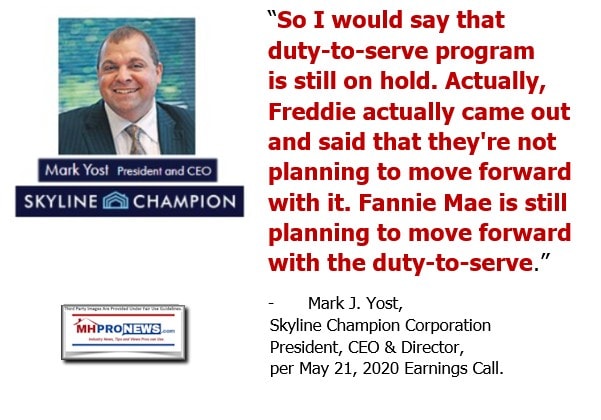
What happened to years of hype and promises? Corporate leaders have a fiduciary responsibility to do the best for their investors. Yost himself made a formal statement to Congress. What happened? Where are the long-promised results?
Instead of growth the HUD Code manufactured home industry saw a decline in shipments during an affordable housing crisis. It was a spectacular failure from the point of view of industry independents. Was that by accident or design? The reasons for that question are many, but can be brought into focus with the prior quote from Skyline Champion below.
That statement and what has occurred in recent years begs for federal and state antitrust investigation. But it also calls for shareholders attorneys to probe the issues. These are not items to be shrugged off, because they are arguably prima facie evidence of incompetence – or perhaps worse – of collusion with their other ‘big boy’ MHI members to rig the market place. Yost and his colleagues are intelligent, experienced people. The case for incompetence is thus thin compared to the argument for collusion that is subtly hiding in plain sight. After all, Skyline Champion themselves point to what their historic potential is in manufactured housing. Then why aren’t they achieving that potential? Why were years wasted – and are still being wasted on a program – CrossModTM that insiders in his own firm say is going nowhere fast?
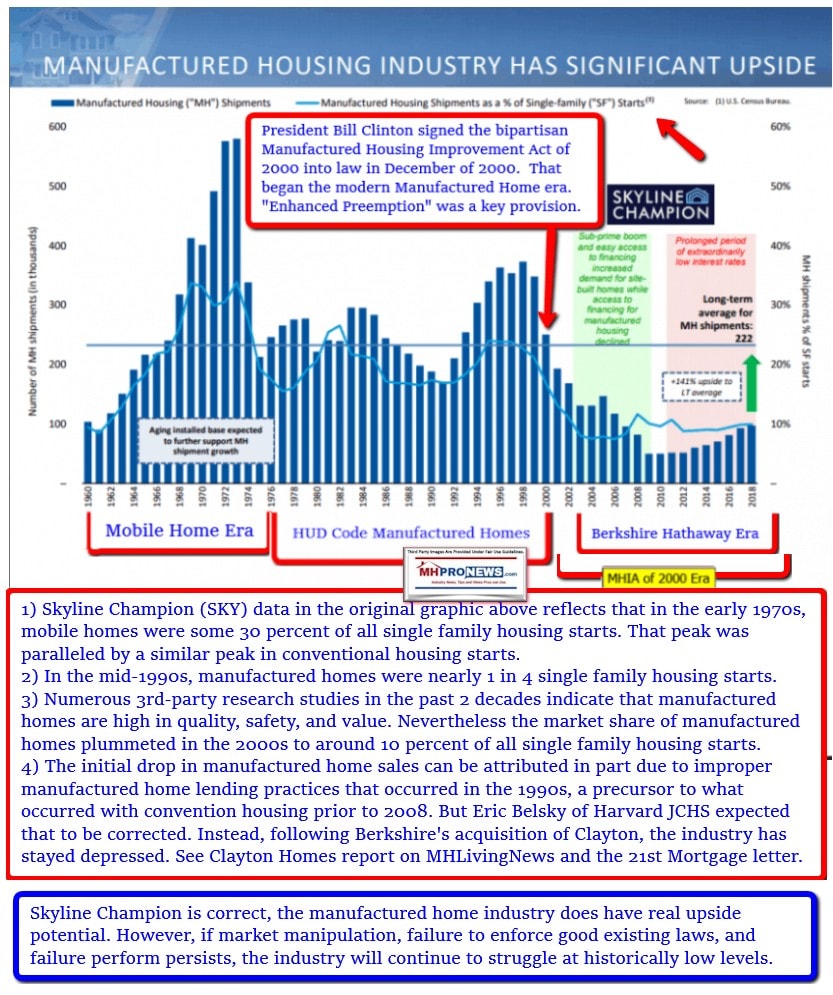
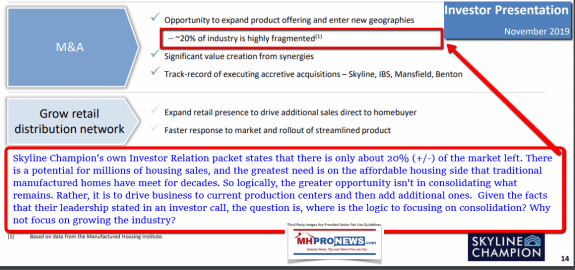
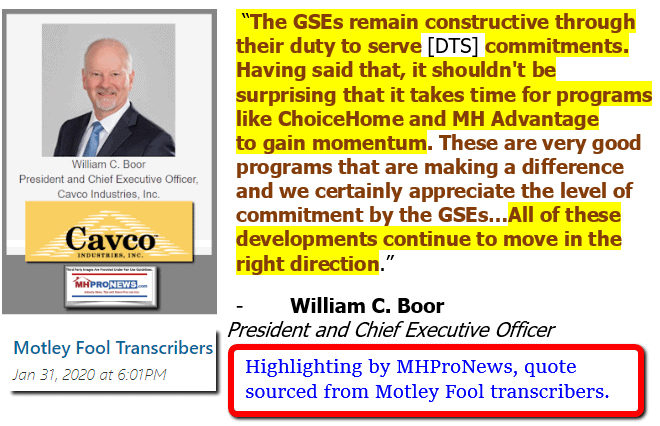
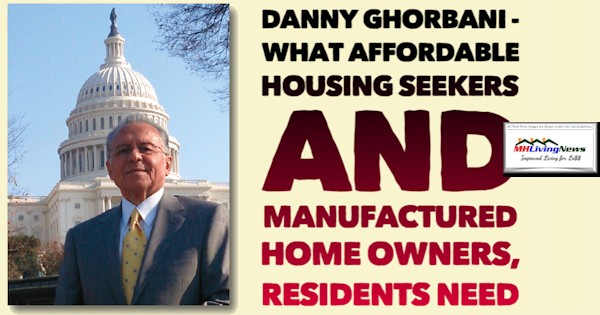
There was significant talk about the new class of manufactured homes that MHI has since dubbed as CrossModTM, which Fannie Mae calls MH Advantage® and Freddie Mac calls ChoiceHomeSM. What happened to all that happy talk? Or was it paltering, double talk and razzle dazzle? When statements by various MHI members are lined up and compared to the facts, it is an alarming concern for those who care about affordable housing and small businesses.
Comments by corporate officials in such matters are supposed to be true to the best of that person’s knowledge and belief. The same is true for testimony to Congress. The RV industry is recovering quickly. Will MHVille do the same? Or will there be even more posturing and game playing by corporate leaders focused on moat-building, consolidation and M&A instead of serving the public that needs affordable housing to the tune millions of units? Who said? How about MHI’s prior president?
MHI CEO Dick Jennison’s Pledge – 500,000 New Manufactured Home Shipments
There are so many odd – SEC, FTC, DOJ type of odd – that it begs for federal, state and shareholders investigations. There is more to know, found in the reports linked above and below. But an upcoming report, likely tomorrow, will shed light on just how disconnected some of these statements from publicly traded company officials are.

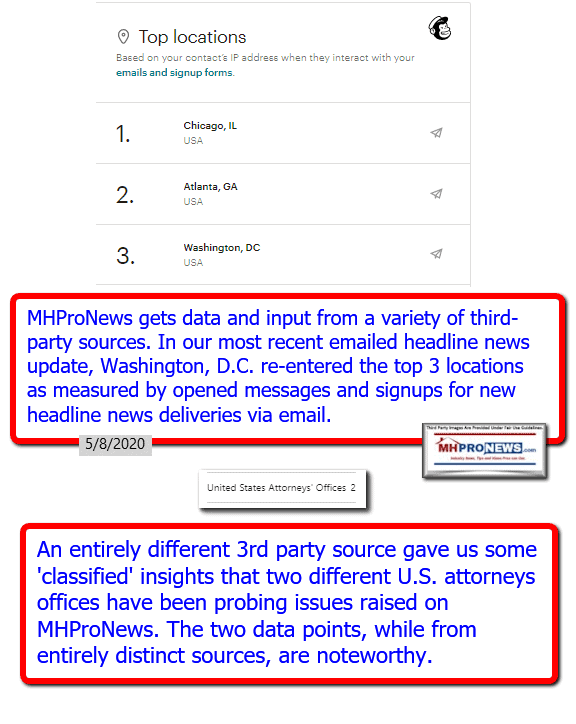
Thousands of industry readers daily vote with their browsers, devices, and time making this the runaway #1 place for authentic manufatured housing “Industry News, Tips, and Views Pros Can Use” © where “We Provide, You Decide.” © ## (Affordable housing, manufactured homes, reports, fact-checks, analysis, and commentary. Third-party images or content are provided under fair use guidelines for media.) (See Related Reports, further below. Text/image boxes often are hot-linked to other reports that can be access by clicking on them.)
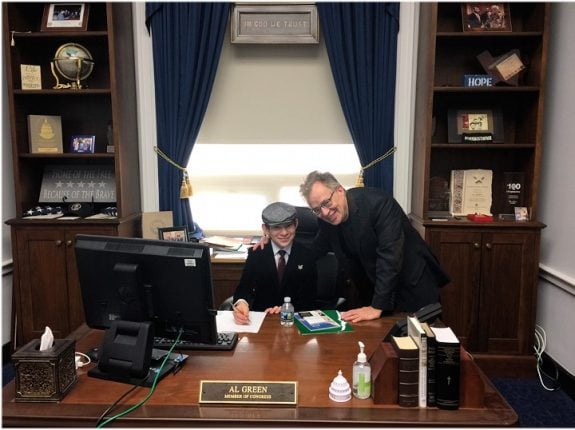
By L.A. “Tony” Kovach – for MHLivingNews.com.
Tony earned a journalism scholarship and earned numerous awards in history and in manufactured housing. For example, he earned the prestigious Lottinville Award in history from the University of Oklahoma, where he studied history and business management. He’s a managing member and co-founder of LifeStyle Factory Homes, LLC, the parent company to MHProNews, and MHLivingNews.com. This article reflects the LLC’s and/or the writer’s position, and may or may not reflect the views of sponsors or supporters.
Connect on LinkedIn: http://www.linkedin.com/in/latonykovach
Related References:
The text/image boxes below are linked to other reports, which can be accessed by clicking on them.
“Trailer Sales” Surge, Per Mainstream Media – Takeaways for Manufactured Home Independents?
“Never Let a Good Crisis Go To Waste” – COVID19 Pandemic – Problems and Solutions


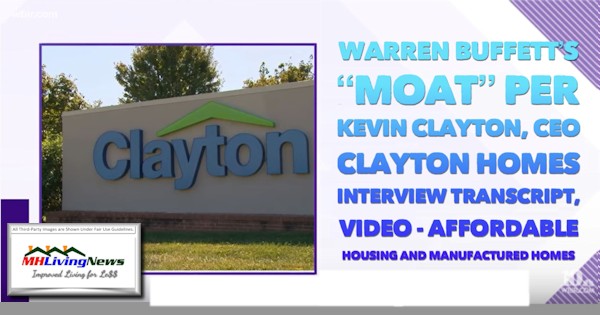
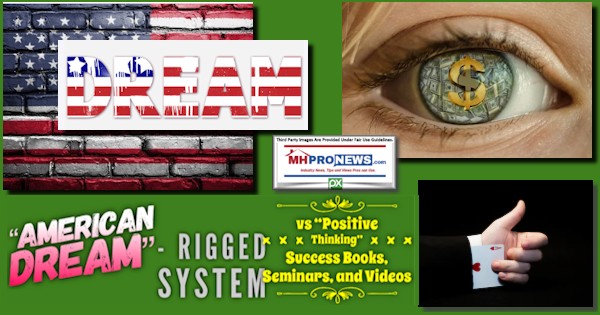




“MHI Lies, Independent Businesses Die” © – True or False? – Berkshire’s Joanne Stevens Strikes Again



